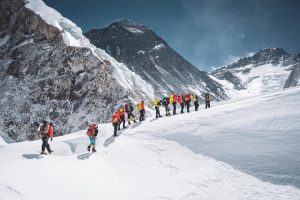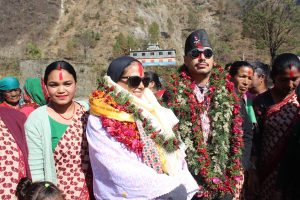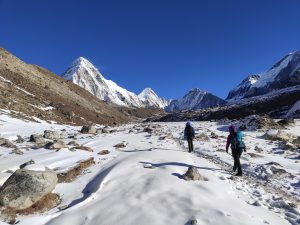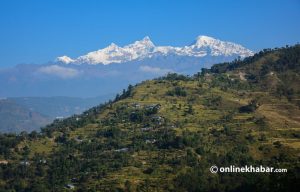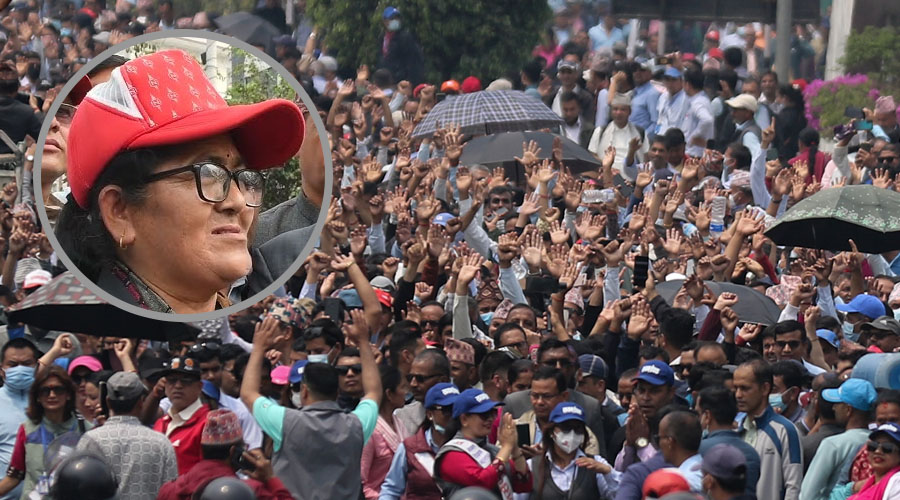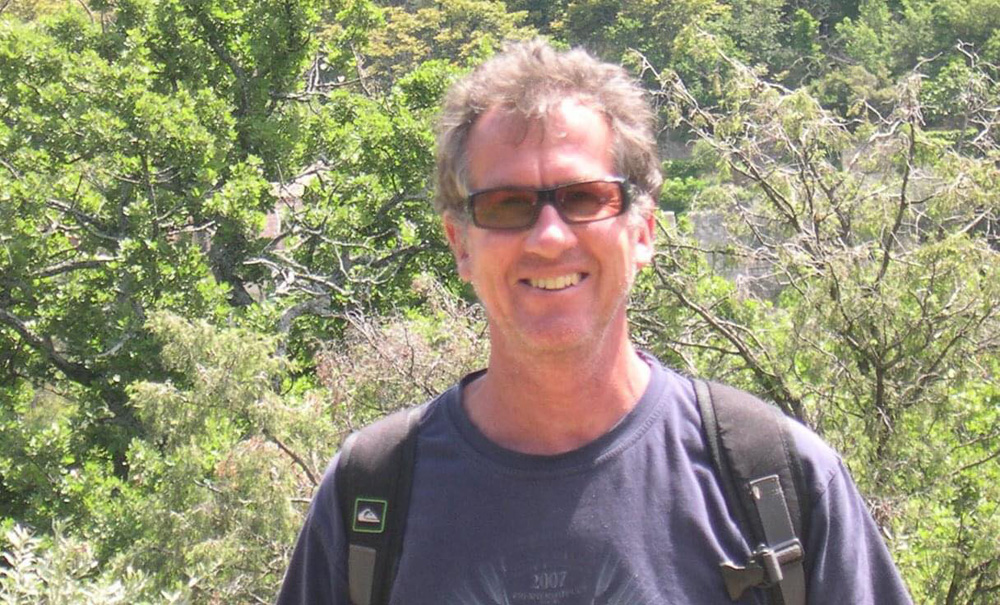
Simon Balderstone was a member of Australia’s first Everest expedition in 1984. Since then, he has kept himself connected to Nepal forever. After the summit, Balderstone established Australian Himalayan Foundation to collect funds and support various development initiatives in the Himalayan regions of Nepal.
As the spring is considered the easiest season to climb mountains in Nepal, the season would see thousands of climbers lining up to conquer Everest and other snowy hills in the past years. However, due to the Covid-19 crisis, the mountains have worn a deserted look this time. Balderstone says he is sad about it as he misses his climbing journey a lot. In this context, Manarishi Dhital for Onlinekhabar has talked to Balderstone about his works in Nepal, Nepal’s mountaineering, its opportunities and challenges.
Excerpts:
Simon, you say you miss the mountains a lot. How did you happen to miss them as you were born and brought up in the country surrounded by oceans?
I often think about how I become a Himalayan trek guide, a member of an Everest expedition, and then a co-founder and the chairman of Australian Himalayan Foundation despite being born in a very flat ‘outback’ part of Australia, a flat country surrounded by a sea. But from a very early age, I was fascinated by mountains, one of the first ‘grown-up’ books I ever read was ‘Ascent of Everest’, Sir John Hunt’s account of the successful 1953 British Everest expedition. It was so because mountains were something very different to what I was experiencing as a child, and had a certain mystique and excitement factor. But, it was probably more because I always loved being outdoors (I grew up on a farm) and in nature, and that led to bushwalking, then, being adventurous, trekking in the Himalaya, then being a trekking guide there, and through trek guiding friends, being a member of the successful 1984 First Australian Everest Expedition.
Also, importantly, I grew up being aware of and inspired by the amazing education and health work Sir Edmund Hillary was doing in the Himalayan region following his first ascent, and that drew me to the mountains too. It was as a journalist I first met Sir Edmund, and then as a guide, with mutual friends, I met and became friends with his son Peter. Many years later, still inspired by the work of Sir Edmund and also our love of the people of the Himalayas, a group of us, trekking and climbing friends, including Peter, formed the Australian Himalayan Foundation, in 2002, to carry on and expand Sir Ed’s legacy. So mountains – particularly, the Himalayas – have always been special to me, and so have the people who live there, and Sir Edmund, his legacy, and the greatest of all mountains sit at the core of the Australian Himalayan Foundation’s formation, work and heritage.
Did you find climbing the mountain challenging or blissful?
Being a member of the 1984 first Australian Everest expedition was a magnificent experience – not only for the lifelong bonds and friendships formed, which later became a big part of the formation of the foundation but also for the amazing good fortune of being on that great mountain, out in pure nature and pristine wilderness, engaged in an exhilarating experience. It was sometimes challenging, but that is not unexpected, as we all knew that of course, the forces of nature were much more powerful than us and that the mountain – Mother Goddess of the Earth – was definitely /’in charge! In general, I find mountains extremely blissful – though I was never a real mountaineer; I was more a scrambler who was very used to the rigours and experience of being on an expedition or trek. I absolutely always loved being in the mountains, for their beauty, grandeur and relative peace and tranquillity compared to city life, and having nature surrounding me above, below and all around.
Yes, it is sometimes challenging, but in a good, rewarding way. And I look back at even the most challenging times with great satisfaction, for example: when I broke my back on a trek in the Lower Solu Khumbu, but walked for another five days, with a group of foundation supporters, cutting the ribbons on some of the 85 classrooms we the Australian Himalayan Foundation had built after the 2015 earthquakes. And, to be high on a mountain, in pure nature, is also always a great joy.
I still go to the Himalayas most years, often with Peter Hillary, taking the foundation supporters on unique ‘customised’ trips to raise money for Australian Himalayan Foundation’s work and, importantly, for the supporters to see our programmes and the outcomes their donations achieve, firsthand.
But, being in the Himalayas is about more than the mountains themselves, I love and care about the people who live there. Peter Hillary says that people go to the Himalayas because of the mountains, but they go back because of the people. That is so true.
Can you let us know about the work that you have done in the Himalayan region after you returned from climbing Everest?
In 2002, a group of us, friends who had lived, worked and ‘played’ for months and months in the Himalayas over several decades, formed the Australian Himalayan Foundation, to give something back – to make a difference, helping the people of the Himalayas have better futures, and more work and life opportunities, through improved schooling and health services and a better environment. The cofounders were Garry Weare, Peter Hillary, Lincoln Hall, Mike Dillon, Christine Gee, Mark O’Toole, and myself.

Organised by Garry and Peter, we were inspired to form the foundation by the amazing, ground-breaking humanitarian work of Sir Ed, and our love of the people. We were passionate about carrying on and expanding his efforts and legacy, and still are – and we now have a set of practical, cost-effective programmes in Nepal, Bhutan, and northern India. Our flagship programme, the Teacher Training and Quality Education programme is largely modelled on the work of Sir Ed. It provides, through REED, our in-country programme partner in Nepal, teacher training, scholarships for disadvantaged children, and resources for schools, in the very poor Lower Solu Khumbu region, where our Nepal programmes are centred and are making a major difference in improving the education of thousands of children, especially girls. Our mission is to improve the quality of life of the people most in need in remote areas of the Himalayas; we work in partnership with the people of the Himalayas to help the most disadvantaged meet their priority needs through integrated improvements in education, health and environment. At the moment, in this time of Covid-19, we are striving hard, with REED, to have the much-needed education of thousands of children in the Lower Solu Khumbu continue (including through “distance learning”) and lessen the effects of Covid-19.
What is the significance of the Himalayas for the people who reside near seas?
Nepal and the Himalayas seem to have always had a special place in the heart of many Australians, whether they live by the seas or in the bush. Maybe it is that the mountains, the “roof of the world”, hold a special mystique for us, and inspire us, and certainly thousands of Australians every year love going to Nepal and nothing beats being there for real appreciation, lock in that place in the heart for Nepal, the Himalayas, and Nepalis. And, there is inspiration and excitement created by the heroic deeds of climbers, including many Australian mountaineers. Whatever the reason, there is a special bond and connection between many Australians and Nepal, and the Australian Himalayan Foundation gets great support from the Australian community to fund its work.
Do you agree that we need to preserve the Himalayas to save this universe from global warming?
Actually, climate change is already having a significant effect on the Himalayas, with changes in temperature, glaciers, snowfall and rainfall affecting Himalayan communities, and, because of the huge importance of the Himalayas as the source for many major river systems, also affecting major parts of Asia. The receding of glaciers is a major problem in mountains across the world, and climate change adaptation is going to be vital for communities in the Himalayas. There are specific effects of climate change, glacial lake outburst floods, which have already devastated several Himalayan communities. Australian Himalayan Foundation has begun an Environmental Youth Climate Initiative in Nepal and is hoping to develop a climate change adaptation programme across the Himalayas in the near future.
What do you think will be Covid-19’s impacts on adventure tourism and mountain climbing?
I think and hope that adventure tourism and mountain climbing will return quickly, making a rapid and full recovery. The big effect of Covid-19 on these areas has been the huge loss of business and personal incomes, with the lockdown and the absence of tourists. So, I hope these areas are able to be safely opened up as soon as possible, so peoples’ livelihoods and local businesses can recover and get back up and running. But, this will depend a lot on the timing and level of incidence of Covid-19 in mountain areas.
Lastly, what is your relationship with Nepali Australians?
There is a large and wonderful Nepali diaspora in Australia, including more than 50,000 Nepali students studying in Australia, and I and other AHF directors have many close personal connections with that community, and we attend and speak at many functions held by the community. But, we, Australian Himalayan Foundation, aim to develop a much stronger relationship with the Nepali community in Australia through partnerships and arrangements with Nepali organisations in Australia and hope to maximise our support for the people of the Himalaya through that. Of course, one of the AHF directors, Nepali-Australian Amit Thapa has a very close relationship with many Nepalis in Australia, and Amit will be helping us to forge very close ties with them and the many Nepali-Australian organisations.




